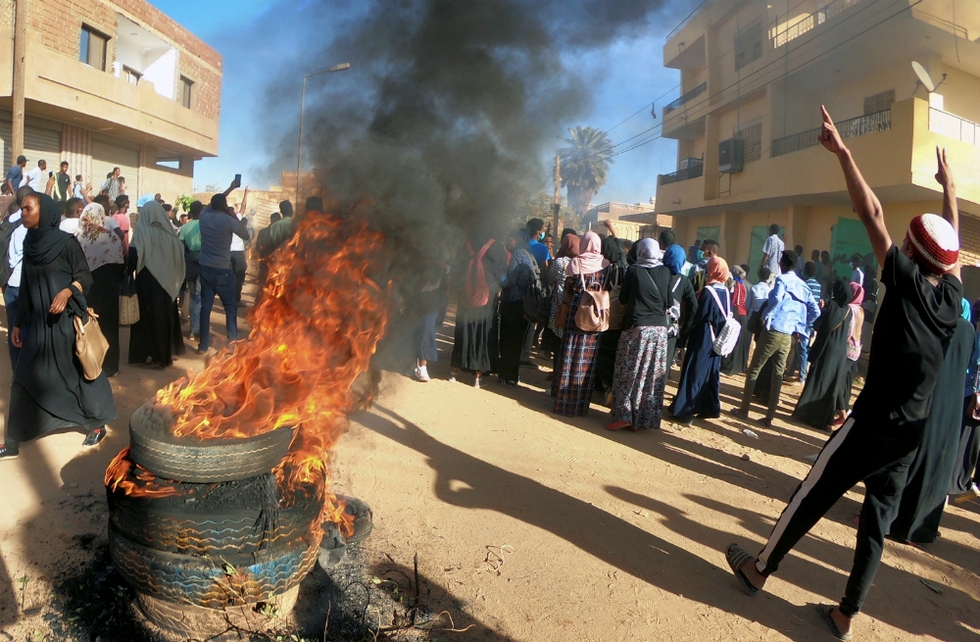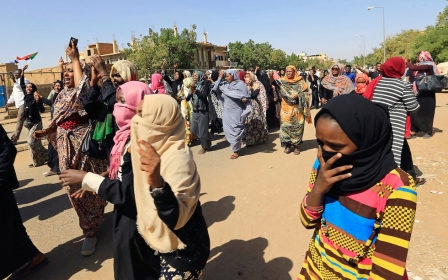Heads shaved, beaten, shot: Sudanese protesters accuse authorities of abuses

KHARTOUM - Locks of hair shorn from the heads of men and women have become a common sight on the streets of Sudan in the past month.
They were cut by members of the security forces from the heads of protesters who have been taking to the streets to call for an end to the almost 30-year rule of President Omar al-Bashir.
Those crowds, often chanting their intention to march “peacefully”, have been met with tear gas and live fire that has killed more than 40 protesters, according to rights groups, but also with detentions and beatings - a pattern of harassment and humiliation many young Sudanese say has become widespread.
There have been more than 300 protests against the government since the unrest began on 19 December, according to human rights group Amnesty International, and there have been scores of arrests reported at many of them, with security forces often storming nearby homes to look for sheltered protesters.
Translation: Thank god, today I was released from jail
Abul Wahab Ahmed, 19, told MEE that he was one of those caught and detained by security forces at a protest in southern Khartoum.
“They beat me and many other protesters and then they shaved my head in a really humiliating and barbaric way,” Ahmed said.
“They released me after two hours of detention in their vehicles, dropping me off in the main streets of al-Kalakla where I live,” he said.
Sudanese journalist Bahram Abdul Moniem, who has been arrested twice since protests started, told MEE he has suffered and witnessed the beatings himself.
“I and other journalists were arrested together and beaten together by the security agents. I saw hundreds of young protesters being violently beaten by the security agents.”
The image of severed braids scattered on roads in the capital Khartoum last week has drawn attention to how the security forces have been targeting women.
Sara Daif Allah, 35, told MEE she was arrested in downtown Khartoum alongside 14 other women activists and only released after hours of being beaten and threatened.
“That was a bad experience for me and other colleagues; I was beaten and the security personnel intentionally harassed and abused the female protesters,” she said.
She said she believed women were being singled out to intimidate and discourage them from joining the demonstrations.
Sudanese American freelance editor Sara Elhassan, who has been closely following the protests, said the cutting of protesters’ hair is “a way to degrade and humiliate, and therefore make a person think twice before trying to dissent again.
“For women particularly, it’s dehumanising because it also plays into societal concepts of femininity and womanhood - women’s hair is an integral part of their femininity, as society would have us believe, and so getting her hair cut off is stripping her of that which makes her womanly.”
She said some women detained by Sudanese intelligence agents have been physically and sexually abused.
“According to eyewitness reports, the women who were attacked by security forces were beaten and had their hair cut in the neighbourhood square where the protests were originally taking place, and that’s where their hair was found and photographed.
“This, along with the vicious way that security forces handled the Burri protest, are proof that the NISS [National Intelligence and Security Service] regime wanted to make an example of them.”
Rallying around the dead
Sharifa Ahmed's home has become a rallying point for the protests, as her 25-year-old son, Dr Babikir Abdul Hamid, was one of three who died after being shot on Thursday while providing medical help to injured protesters in the flashpoint Burri neighbourhood of Khartoum.
“The last moment I saw Babikir was on Thursday morning, when he went to work to save people. I told him to take care of himself and he told me ‘don’t worry, the people are been targeted everywhere and we should work to save them’,” she said between tears. She has vowed not to accept mourning and consolation until Bashir leaves ofice.
A friend of Abdul Hamid’s told MEE, on condition of anonymity, that he was killed while treating some of the injured.
“We were working in a house to rescue some wounded people and the security officers prevented us from taking them to the hospital. So my colleague Babikir went out of the house to negotiate with them, but one of the security agents shot him in the chest,” said the friend, who is also a doctor.
Deaths in custody
Eyewitnesses and activists have told MEE that abuses against protesters and detainees are widespread and the African Centre for Justice and Peace Studies said emergency laws have been used to facilitate the crackdown.
It also raised suspicions about the circumstances of some of the deaths, which happened while in custody.
“Abdul Rahman Alsadiq Mohamed Alamin, an art student at the University of Khartoum, was found in the Nile River. It appeared that he had drowned. His family refused to receive his body until an autopsy was done. It is reported that his body showed clear signs of having been tortured or subjected to ill-treatment,” the centre said in a statement.
The Sudan Democracy First Group human rights organisation chairman, Anwar Alhaj, has called for an independent investigation into the deaths of the protesters.
He said that an investigation already announced by the government was actually launched to cover up the abuses.
“The Sudanese people don’t trust such committees as they have long experience with these government institutions,” he said, pointing to a probe into the killing of 200 protesters during nationwide protests in 2013 that “produced nothing”.
“The Sudanese people don’t trust in the transparency of the justice system in Sudan,” he said.
“We call on the international community and international human rights organisations to impose the highest pressure it can in order to prevent the Sudanese government from committing more crimes against the protesters and to help Sudan to build a real democracy.”
This article is available in French on Middle East Eye French edition.
Middle East Eye propose une couverture et une analyse indépendantes et incomparables du Moyen-Orient, de l’Afrique du Nord et d’autres régions du monde. Pour en savoir plus sur la reprise de ce contenu et les frais qui s’appliquent, veuillez remplir ce formulaire [en anglais]. Pour en savoir plus sur MEE, cliquez ici [en anglais].




